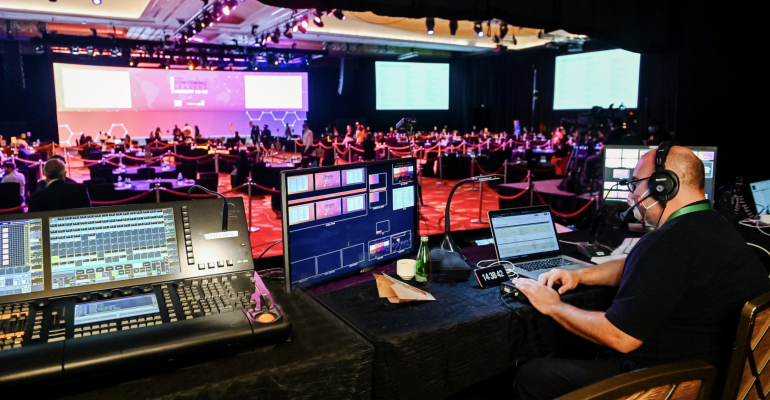For hybrid events, the several-hundred-thousand-dollar question is this: What should they cost compared to the former in-person-only meetings they are replacing?
John Pistotti, an experience architect for Endless Events, a virtual-event provider that now coordinates hybrids, says that “there’s a big misconception that hybrid and virtual iterations of a meeting are less expensive than an in-person iteration. With hybrids, you’re paying for one or more physical venues, and the virtual platform is essentially another venue that must be paid for.” Add in production costs and staffing, and suddenly the price tag of a hybrid might be pretty close to that of an exclusively in-person meeting.
“Maybe the biggest challenge I see for planners is that they are mandated to create these experiences at lower cost than the prior in-person experience,” Pistotti notes. “How do they explain to their executives that there are a lot of new logistical elements that translate into cost? Executives know that there are some things you can accomplish through Zoom that you could see as becoming part of a hybrid event. But trying to save money on the platform usually causes attendee satisfaction to plummet. And if the price to attend the event is pretty low, registrations will increase but attrition for the event will be very high and engagement during the event will suffer, all because attendees have no true investment in the event. It is more important for planners to have a production partner who can elevate the experience for virtual attendees.”
Richard Stewart, managing director, North America, for experiential event agency VOK DAMS, adds this: “Companies that were doing large events—flying clients and prospects in, using hotel rooms and event space, buying food and beverage, and doing big on-site production—should reallocate a lot of that money towards the production element of hybrid events. It will be worth it.”
The 2021-2022 Outlook for Hybrids
“Our belief is that post-Covid, even when meetings can come back to full capacity in person, most of them are going to be hybrid,” says James Frankis, a director of product for high-tech venue operator Convene. “From their 2020 experiences with virtual, planners see they can have such an increase in audience reach that just about every in-person meeting could benefit from having some type of virtual component to it.”
Richard Stewart agrees. In fact, “many of our clients are kind of there already because of what we had to do on the fly in 2020: make the audience virtual but use studios around the world to allow brand leaders to present. So, the speakers can be anywhere and eventually we’ll have audiences in front of them in some of those places. In the facilities we’re using, a studio can have socially distanced seating for perhaps 50 people, so that’s a near-term goal” among some of his firm’s clients.
Shayna Moskowitz, DES, director of meeting and event technology for Part 2 Events, believes that “hybrid events in the next 12 months are going to be about improving the remote-audience experience, though the ‘reasonable cost’ part is a sticking point. There’s the ideal, and then there’s what people can realistically execute.”
For instance, events where content comes from various in-person locations in real time won’t become commonplace in 2021. John Pistotti notes that “the cost is multiplied by the number of sites needing a production and streaming set-up to deliver programming beyond that site.” Then again, “I think that we will soon see costs start coming down because of more users, and users will better understand how to do things,” says Michael Judeh, senior director of audiovisual technology for Convene. “I see a future not too far off where we are bridging multiple sites and pulling content from multiple places.”
In the meantime, “this year is going to challenge planners; they will need a lot of skills training,” Judeh adds. “The learning curve for hybrids, with all the technical terms and equipment plus the costs that they have not encountered before, is significant.” However, “this challenge for the meetings industry is creating really interesting opportunities,” says Pistotti. “Planners can completely reimagine the possibilities—no longer are there rules that make events bound to a specific place and a specific time. But event budgets need to be shifted away from what they used to be spent on and towards the technology.”
Part 2: Hybrid Meetings: Prepping Speakers, Evaluating Tech Platforms





